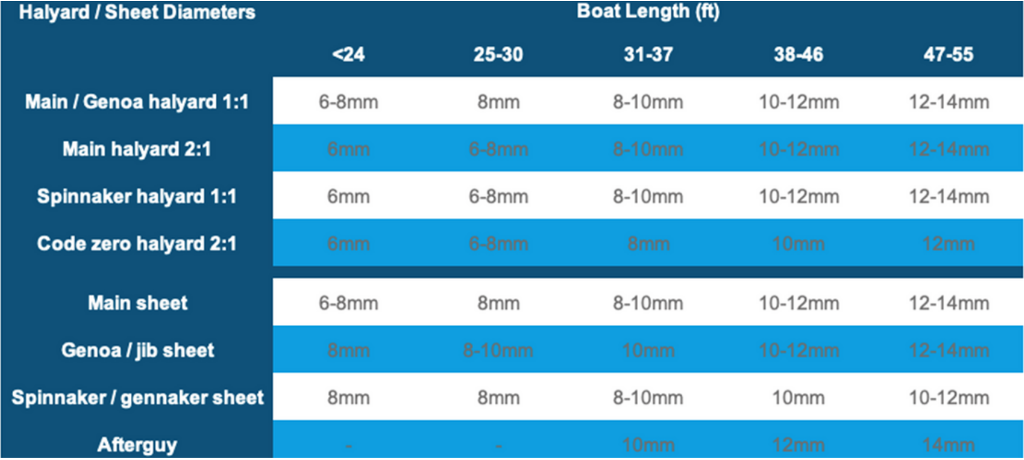Segelleine & Tauwerk
Segelleine & Tauwerk für Segelyachten haben in den letzten 20 Jahren erhebliche Fortschritte gemacht. Polyester und Dyneema® zählen zu den häufigsten Materialien im Kern und bieten höchste Festigkeit und Zuverlässigkeit. Jedoch existiert eine Vielzahl exotischer Fasern, die in geflochtenen Manteln eingesetzt werden können, um Leistung und Zuverlässigkeit für unterschiedliche Anwendungen zu verbessern. Segelleine sind essenzielle Bestandteile jedes Segelboots oder Wasserfahrzeugs allgemein und erfüllen zahlreiche Funktionen, von der Sicherung der Segel bis hin zum Ankern. Lesen Sie mehr...
Die Wahl der richtigen Segelleine & Tauwerk für Ihr Boot und die jeweiligen Anwendungen ist entscheidend für Sicherheit, Zuverlässigkeit und Leistung auf dem Wasser. Im Folgenden betrachten wir die besten Materialien für moderne Segelleine & Tauwerk, verschiedene Tauwerk-Konstruktionen und deren ideale Anwendungsbereiche.
Was sind die besten Materialien für moderne Segelleine & Tauwerk?
Nylon-Tauwerk ist aufgrund seiner hervorragenden Festigkeit, Elastizität und Widerstandsfähigkeit gegen UV-Strahlen und Abrieb beliebt. Es ist relativ preisgünstig und bietet zuverlässige Leistung unter verschiedenen Bedingungen.
Polypropylen-Segelleine sind leicht, schwimmfähig und nehmen kein Wasser auf. Dies macht sie ideal für Anwendungen, bei denen Auftrieb entscheidend ist, wie Schleppleinen oder schwimmende Festmacher.
Polyester-Tauwerk zeichnet sich durch geringe Dehnung, hohe Festigkeit sowie Widerstandsfähigkeit gegenüber Sonnenlicht und Chemikalien aus. Diese Segelleine sind ideal für Anwendungen, bei denen minimale Dehnung und hohe Strapazierfähigkeit entscheidend sind, z.B. Fallen und Kontrollleinen. Der Großteil geflochtener Mäntel besteht überwiegend aus Polyester aufgrund dessen Abriebfestigkeit und ausgezeichnetem Grip. Für Fahrtenboote und Club-Racer bis etwa 45 Fuß Länge ist Polyester das Standardmaterial.
Dyneema®-Segelleine aus ultrahochmolekularem Polyethylen (UHMWP) bieten ein außergewöhnliches Verhältnis von Festigkeit zu Gewicht, minimale Dehnung und Abriebfestigkeit. Diese Segelleine & Tauwerk werden bevorzugt bei Performance-Anwendungen für Boote unter 45 Fuß sowie bei Fahrten- und Regattayachten über 45 Fuß eingesetzt. Sie sind leicht und zuverlässig. Die zwei Hauptvarianten von Dyneema® sind SK78, mittlerweile Standardmaterial (hat größtenteils SK75 ersetzt), sowie SK99 für höchste Performance bei minimalster Dehnung.
Geflochtene Mantelfasern: Polyester ist das primäre Material für Mantelgeflechte, da es exzellente Handhabung, Haltbarkeit und Abriebfestigkeit bietet. Verschiedene exotische Fasern können zusätzlich eingesetzt werden, um spezifische Eigenschaften zu verbessern. Technora® und Cordura® erhöhen beispielsweise Abriebfestigkeit und Grip in Klemmen, Kevlar und Vectran verbessern die Hitzebeständigkeit, während PBO (Zylon®) die Gesamtfestigkeit erhöht.
Welche Tauwerk-Konstruktionen gibt es?
Geschlagenes Tauwerk:
Geschlagenes Tauwerk entsteht durch das Verdrillen einzelner Faserstränge. Es ist eine traditionelle und kostengünstige Lösung mit guter Festigkeit und Haltbarkeit, ideal für Festmacherleinen, Fenderleinen, Lazy-Jacks und andere Anwendungen ohne Performance-Anspruch.
Einfachgeflecht:
Einfach geflochtenes Tauwerk besteht aus mehreren, ineinander geflochtenen Kernfasern, ist besonders stark und flexibel. Ohne Mantel bietet es bei gleichem Durchmesser eine höhere Bruchlast und geringere Dehnung als Doppelgeflecht. Es ist einfach zu spleißen und vielseitig einsetzbar für Anwendungen mit hoher Belastung und wenig Bewegung, z.B. Vorsegel-Fallen, Taljen oder Kontrollleinen.
Doppelgeflecht:
Doppelgeflecht besteht aus einem geflochtenen Kern, der von einem geflochtenen Mantel umgeben ist. Diese Konstruktion bietet erhöhte Festigkeit, Haltbarkeit und Abriebfestigkeit. Doppelgeflecht ist die bevorzugte Lösung für stark belastete Anwendungen wie Fallen und Schoten. Für Boote bis 45 Fuß ist ein Polyester-Doppelgeflecht (Polyesterkern und Polyester-Mantel) die Standardlösung. Für größere Boote und höhere Performance kann der Kern zu SK78 Dyneema aufgerüstet werden, und der Polyester-Mantel kann mit zusätzlichen Fasern ergänzt werden, um Grip, Abrieb- oder Hitzebeständigkeit je nach Bedarf zu verbessern.
Kann ich dieselbe Segelleine für Fallen und Schoten verwenden?
Wichtige Aspekte bei der Verwendung derselben Segelleine & Tauwerk für verschiedene Anwendungen:
1. Kompatibilität: Segelleine & Tauwerk können sowohl für Fallen als auch Schoten verwendet werden, sofern sie die Anforderungen beider Anwendungen erfüllen. Faktoren wie Festigkeit, Dehnung und Handling sind entscheidend.
2. Belastung: Fallen und Schoten unterliegen unterschiedlichen Belastungen. Achten Sie auf ausreichende Festigkeit und minimale Dehnung des Tauwerks entsprechend der jeweiligen Anwendung. Festigkeit und Steifigkeit hängen maßgeblich vom Kernmaterial ab, während der Durchmesser die Festigkeit zusätzlich beeinflusst. Eine Größentabelle für Fallen und Schoten bietet hierbei Orientierung.

3. Handling: Aufgrund ihrer spezifischen Funktionen benötigen Fallen und Schoten unterschiedliche Handling-Eigenschaften. Wählen Sie Segelleine & Tauwerk, die Grip, Flexibilität und einfaches Handling entsprechend den Anwendungsanforderungen bieten.
4. Haltbarkeit: Sowohl Fallen als auch Schoten sind dauerhaftem Verschleiß durch Nutzung und Umwelteinflüsse ausgesetzt. Wählen Sie Segelleine & Tauwerk mit hoher Abriebfestigkeit und UV-Stabilität für langfristige Haltbarkeit.
Zusammenfassend sind Segelleine essenzielle Bestandteile jedes Boots, die von Segelkontrolle bis hin zu Ankermanövern und Schleppaufgaben vielfältige Funktionen erfüllen. Durch Kenntnis der besten Materialien, Tauwerk-Konstruktionen und deren vielfältige Einsatzmöglichkeiten können Bootsbesitzer fundierte Entscheidungen treffen, um Sicherheit, Zuverlässigkeit und Leistung auf dem Wasser entscheidend zu verbessern.

To install this Web App in your iPhone/iPad press
![]() and then Add to Home Screen.
and then Add to Home Screen.



